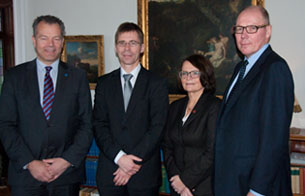Swedish-Swiss Partnership in Accelerator Science
“Young researchers need to start planning now”
NEWS
KTH, Stockholm University and Uppsala University have signed an agreement with two leading Swiss research institutions covering technology development for the next generation of free-electron lasers and collaboration in photon and neutron science. The agreement promises a world of new research opportunities in materials and life sciences.

KTH President Peter Gudmundson was the host on November 28 as top administrators from Stockholm University and Uppsala University formally committed to a long-term collaboration programme with École Polytechnique Fédérale de Lausanne and the Paul Scherrer Institute (PSI) in Switzerland. The five institutions will work together to design experiments and develop new accelerators for investigation of molecular structures and unfathomably rapid events.
“This collaboration will put us on the forefront of several of the most exciting fields in physics today”, said Ulf Karlsson, KTH Professor of Materials Physics. “We expect this to be the starting signal for large-scale nano-level characterisation. One sign of how important these technologies are is that European investments alone will be at least €4.5 billion over the next few years.”

The agreement calls for joint development and research exchanges in advanced accelerator technologies, beginning immediately on existing facilities and continuing through the construction of new accelerators over the next five to ten years. The research promises to pay off with practical applications such as lighter, stronger metals, improved fuel cell technologies, high-capacity batteries, insights into the mysteries of superconducting materials and detailed investigation of protein structures in life sciences.
Joël Mesot, Director of the Paul Scherrer Institute, says the collaboration aims to inspire young researchers to plan their careers years in advance, starting now to get the scientific training required to make use of advanced tools that are scarcely more than dreams today. “These technologies take a long time to build”, he says. “If you don’t start now, you’ll lag behind others who have realised how important these new possibilities are and prepared for them.”
Three fields of accelerator technology are included in the agreement:
Free-electron lasers (FELs) perform like conventional lasers in producing a high-powered beam of coherent electromagnetic radiation, with the difference that the radiation from an FEL is composed of relativistic electrons — that is, moving at nearly the speed of light. The FEL lasing medium moves freely through a magnetic structure, hence the term free electron. The free-electron laser has the widest frequency range of any laser type, ranging in wavelength from microwaves, to the visible spectrum, to ultraviolet, to X-rays.
Planned new FEL facilities will allow scientists to map the atomic details of viruses, decipher the molecular composition of cells, take three-dimensional images of nano structures, film chemical reactions and study processes such as those occurring deep inside planets.
The Swedish and Swiss signatories to the new collaboration are all involved in the European XFEL project currently under construction in Hamburg, Germany with commissioning scheduled for 2015. In addition, PSI will build the SwissFEL facility, employing different technologies to achieve similar performance characteristics.
Neutron scattering is one of the most effective ways to obtain information on the structure and dynamics of condensed matter. A wide scope of problems, ranging from fundamental to solid state physics and chemistry, and from materials science to biology, medicine and environmental science, can be investigated with neutrons. In addition to scattering techniques used in basic research, non-diffractive methods can also be applied to industrial applications.
Paul Scherrer Institute is home to the SINQ neutron research facility — known as a spallation source — that produces a beam of neutrons for use in materials research and investigation of biological substances. Under the new agreement, Swedish researchers will bring their experiments to SINQ for “beamtime”, widening the range of research conducted at the facility.
The five institutions will also be active in the European Spallation Source (ESS), a higher-power facility to be funded and operated by a partnership of 17 European countries. Located in Lund, Sweden, ESS is slated to begin construction in 2013 and become operational in 2019.
Synchrotron radiation research produces streams of charged particles that can be used to probe the structure of matter from the sub-nanometer level of electronic structures to the micrometer and millimeter level important in medical imaging.
Since 2001, PSI has operated Swiss Light Source, a synchrotron accelerator facility open to researchers from around the world. MAX IV, a next-generation synchrotron accelerator, is currently under construction in Sweden.
Kevin Billinghurst | kb2@kth.se
For more information: Ulf Karlsson, KTH Professor of Materials Physics, ulfka@kth.se.
École Polytechnique Fédérale de Lausanne

